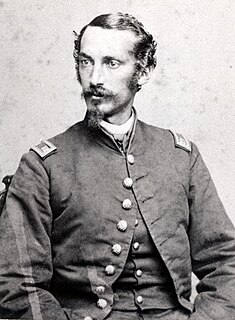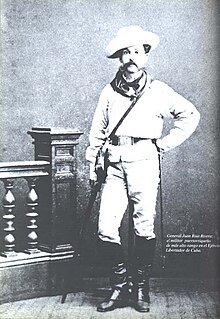 W
WIgnacio Agramonte y Loynáz (1841–1873) was a Cuban revolutionary, who played an important part in the Ten Years' War (1868–1878).
 W
WJosé Quintín Bandera Betancourt was a military leader of the Cuban insurrection against the Spanish during the Cuban War of Independence. In 1906, Bandera, led an army of insurgents toward Havana, and was killed near Punta Brava, a village close to Havana.
 W
WAgustín Cebreco Sánchez, was a Cuban major general and politician of the Mambí Army.
 W
WCarlos Manuel de Céspedes del Castillo was a Cuban revolutionary hero. Cespedes, who was a plantation owner in Cuba, freed his slaves and made the declaration of Cuban independence in 1868 which started the Ten Years' War (1868–1878). This was the first of three wars of independence, the third of which, the Cuban War of Independence led to the end of Spanish rule in 1898 and Cuba's independence in 1902.
 W
WFrancisco Adolfo "Flor" Crombet Tejera was a Cuban patriot and participated in the three independence conflicts. He was appointed head, in commission, of the division of Cuba and Bayamo and was Major General. He landed with Antonio Maceo Grajales for "Duaba". He participated in the Ten Years' War and protested with Maceo in Mangos de Baraguá in defense of the total and definitive independence of Cuba.
 W
WTomás Estrada Palma was a Cuban politician and the first President of Cuba. Initially he was the president of the Cuban Republic in Arms during the Ten Years' War and again between May 20, 1902, and September 28, 1906. His collateral career as a New York City area educator and writer enabled Estrada Palma to create Pro-Cuban literature aimed at gaining sympathy, assistance and publicity. He was eventually successful in garnering the attention of influential Americans. He was an early and persistent voice calling for the United States to intervene in Cuba on humanitarian grounds. He was the first president of Cuba, between May 20, 1902, and September 28, 1906. During his presidency his major accomplishments include improving Cuba's infrastructure, communication, and public health.
 W
WAdolfo Fernández Cavada was a soldier and diplomat, an officer in the Union Army during the American Civil War who served as captain in the Philadelphia 23rd Pennsylvania Infantry Regiment, a regiment of the Union Forces, with his brother, Colonel Federico Fernández Cavada. He served with distinction in the Army of the Potomac in the battles of Fredericksburg and Gettysburg and was a "special aide-de-camp" to General Andrew A. Humphreys. After the war, Fernández Cavada was appointed as consul in Cienfuegos, Cuba. He joined his brother, who had been in Trinidad, in the Cuban insurrection against Spanish rule and succeeded him as Commander-in-Chief of the Cinco Villas. He was killed in action.
 W
WFederico Fernández-Cavada was an officer in the Union Army during the American Civil War and a diplomat, as well as commander-in-chief of all the Cuban forces during Cuba's Ten Years' War. Because of his artistic talents, he was assigned to the Hot Air Balloon Unit of the Union Army. From the air he sketched what he observed of enemy positions and movements. On April 19, 1862, Fernández Cavada sketched enemy positions from Thaddeus Lowe's Constitution balloon during the Peninsular Campaign in Virginia.
 W
WPedro Felipe Figueredo, mostly known as Perucho was a Cuban poet, musician, and freedom fighter of the 19th century. In the 1860s, he was active in the planning of the Cuban uprising against the Spanish known as the Ten Years' War.
 W
WCalixto García Íñiguez was a Cuban general in three Cuban uprisings, part of the Cuban War for Independence: the Ten Years' War, the Little War, and the War of 1895, itself sometimes called the Cuban War for Independence, which bled into the Spanish–American War, ultimately resulting in national independence for Cuba.
 W
WMáximo Gómez y Báez was a Dominican Major General in Cuba's Ten Years' War (1868–1878) against Spain. He was also Cuba's military commander in that country's War of Independence (1895–1898). He was known for his controversial scorched-earth policy, which entailed dynamiting passenger trains and torching the Spanish loyalists' property and sugar plantations—including many owned by Americans. He greatly increased the efficacy of the attacks by torturing and killing not only Spanish soldiers, but also Spanish sympathizers. By the time the Spanish–American War broke out in April 1898, Gómez had the Spanish forces on the ropes. He refused to join forces with the Spanish in fighting off the United States, and he retired to a villa outside of Havana after the war's end.
 W
WAlfonso Goulet Goulet was a Cuban revolutionary leader of the late nineteenth century.
 W
WJesús “Rabí” Sablón Moreno was a Cuban military and patriot of the 19th century.
 W
WMariana Grajales Cuello (July 12, 1815 – November 23, 1893) is a Cuban patriot and icon of the women's struggle for equality and the fight for an independent Cuba free from slavery.
 W
WThomas Jordan was a Confederate general and major operative in the network of Confederate spies during the American Civil War. A career soldier in the armies of three nations, he had previously fought in the Mexican–American War, and in 1868 was appointed as chief of staff of the Cuban insurgent army, which fought to achieve independence from Spain. He resigned in 1870 and returned to the United States, where he settled in New York City. Jordan was also a newspaper editor and author, writing articles about the American Civil War.
 W
WLuis Marcano was a Dominican general of the pre-independence Cuban Army during the Ten Years' War.
 W
WLt. General José Antonio de la Caridad Maceo y Grajales was second-in-command of the Cuban Army of Independence.
 W
WJosé Marcelino Maceo Grajales was a Cuban Independence Activist and patriot of the 20th Century.
 W
WManuel Macías y Casado, OIC (1845–1937) was a Spanish general. He served as Governor-General of Puerto Rico during the Spanish–American War and as governor of Melilla, and occupied various other posts. Born in Teruel, Spain, Macías attended the Colegio de Infantería and became a sub-lieutenant at the age of 17. He became a lieutenant in Cuba on January 1, 1863. In December 1863 he was transferred to Santo Domingo. He was promoted to captain in March 1864. He remained in Santo Domingo until 1865.
 W
WJohn Newland Maffitt was an officer in the Confederate States Navy who was nicknamed the "Prince of Privateers" due to his remarkable success as a blockade runner and commerce raider in the U.S. Civil War.
 W
WArsenio Martínez-Campos y Antón, born Martínez y Campos, was a Spanish officer who rose against the First Spanish Republic in a military revolution in 1874 and restored Spain's Bourbon dynasty. Later, he became Captain-General of Cuba. The soldier and politician took part in wars in Africa, Mexico and Cuba and in the Third Carlist War.
 W
WBartolomé de Jesús Masó Márquez was a Cuban politician and military, patriot for Cuban independence from the colonial power of Spain, and later President of the República en Armas.
 W
WModesto Díaz (1826–1892) was a Dominican Major General of the Cuban Liberation Army. He was a member of the Spanish Army in his country of origin during the Dominican Restoration War (1863–1865). He settled in Cuba and was reinstated to active service after the Carlos Manuel de Céspedes uprising. At the suggestion of Luis Marcano, he went to the side of the Cubans, and conducted several victorious battles against the Spanish during the Ten Years' War (1868–1878).
 W
WGuillermo Moncada was one of 29 Cuban generals in the Cuban War of Independence.
 W
WPedro Agustín Periquito Pérez, better known as Periquito Pérez was a Cuban independence political activist.
 W
WCamilo García de Polavieja y del Castillo-Negrete, 1st Marquis of Polavieja (1838–1914) was a Spanish general born in Madrid on July 13, 1838, in a family of merchants. He was an able commander, but considered as brutal as Valeriano Weyler of Cuba.
 W
WHenry Reeve was a Brigadier General in Cuba's Ejército Libertador – more commonly known as the Ejército Mambí – during the Ten Years' War (1868–1878). In his youth, he was a drummer boy in the Union Army during the American Civil War.
 W
WGeneral Juan Rius Rivera, was the soldier and revolutionary leader from Puerto Rico to have reached the highest military rank in the Cuban Liberation Army and to hold Cuban ministerial offices after independence. In his later years he also became a successful businessperson in Honduras.
 W
WCarlos Roloff was a Polish-born Cuban general and liberation activist, fighting against Spain in the Ten Years' War and the Spanish–American War.
 W
WSerafín Gualberto Sánchez Valdivia was a Cuban patriot, a participant of all three Cuban wars of independence, in addition to participating in the Gómez-Maceo Plan. He reached the rank of Major General. He participated in more than 120 fights. He was also a surveyor and teacher. Brother of Colonel Sabás Raimundo Sánchez Valdivia and Brigadier José Joaquín Sánchez Valdivia. He maintained a solid friendship with Máximo Gómez and José Martí, who considered him a brother.
 W
WJulio Sanguily Garritte was a Cuban independence activist and patriot. He was a Major General of the Cuban Liberation Army during the Cuban War of Independence. He was appointed head, in commission, of the division of Cuba and Bayamo. Major General. He landed with Maceo for "Duaba". He participated in the Ten Years' War and protested with Maceo in Baraguá in defense of the total and definitive independence of Cuba.
 W
WBrigadier General José Semidei Rodríguez was a Puerto Rican soldier and diplomat. He participated in Cuban independence movement that immediately preceded the Spanish–American War. Before becoming a brigadier general in the Cuban National Army, Semidei Rodríguez fought in the Cuban War of Independence (1895–1898) as a member of the Cuban Liberation Army, the rebel force which fought for Cuba's independence from Spanish colonial rule. After Cuba gained its independence he continued to serve in that country as a diplomat.
 W
WValeriano Weyler y Nicolau, 1st Duke of Rubí, 1st Marquess of Tenerife was a Spanish general and colonial administrator who served as the Governor-General of the Philippines and Cuba, and later as Spanish Minister for War.